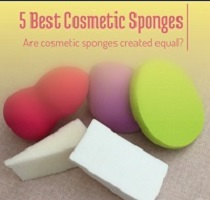5 Best Cosmetic Sponges, Are they all created equal?
Are all Cosmetic sponges created equal?

Walking down the aisle of the cosmetic sections you see so many types of cosmetic sponges. Using your fingers is a thing of the past due to contaminants such as bacteria, oils, and uneven application which can cause clogged pores. It is all about blending to get that most natural flawless finish. So what are the best cosmetic sponges to use? I’ll give you my top 5 in this post.
Some common questions are:
- Does the shape really make a difference? Not really, although having a point to them may help with getting around the eye and nose area a little easier. Having a nice flat surface is key to great coverage.
- Does price matter? No, There really is no difference between a less expensive to a higher-priced sponge.
- Latex vs Latex free?
Synthetic latex- is not as durable and seems to absorb more product which can get costly because of the larger pours in the sponge. As for application there really isn’t much difference. Latex may cause allergies and hold in bacteria so it is recommended to throw them out after each use.
Latex-free –is more durable. It has a smooth denser feel. The makeup application is smooth, even, and flawless. Less product needed. When damp the latex expands a bit more than the latex giving you more sponge area to work with and less product absorption.
- Should I use my sponge wet or dry?
Wet-Using a damp sponge works well for even coverage. Works best with foundations, concealers, BB creams, cream blushes, and highlighters. Also, great for applying moisturizers, and removing makeup as well, although the best sponge to use to remove makeup is the Konjac Sponge.
Dry- is good for powders. I do find the round sponge works well for dry powders.

- How do you use a cosmetic sponge?
Cosmetic sponges are easy to use. Run them under warm water and lightly squeeze the sponge to absorb in water. Gently squash out excess moisture or pat dry with a towel. A damp sponge is all you need to get a flawless finish. Apply product to the tips of the sponge and dab in all areas of your face. Using the flat side to gently apply the product to the face in an outward manner until you have a consistent even finish. Do not stretch or pull at the skin as it may create more fine lines and wrinkles.
- How do you wash a cosmetic sponge?
Run the sponge under warm water with a mild cleanser and gently squeeze out water till it runs clean. Do not twist or wring out as it will damage the sponge. Coconut oil works well although be sure to rinse well. Rubbing alcohol works well by spraying it on after a water rinse or by dipping the sponge in alcohol and rinse with water. I recommend at least rinsing the sponge after each use and cleaning it 2-3 times a week.
1 Powder Puff Soft Triangle
Comfortable and versatile allowing for more even coverage. With finger grip.

2. Teardrop Latex-free Sponge
Teardrop comes in second as I liked the angles it has. The flat edge makes for a nice smooth application along with the point for dabbing makeup on the face.

3. Round or Square Latex-free Sponge
These sponges are ok though are larger than needed when applying makeup you have wasted area as well as it seems more effort is needed to apply to cause more stretch in the skin as well as uneven marks due to the edge hitting your face along with the bending of the sponge. More blending is required.

4. Latex-free Wedge Shaped Sponge
Wedges are much smaller than the others, therefore, more effort is used when applying makeup. They are flimsy and do not give a nice flawless finish like #1 and #2 do
Find it here:
5. Synthetic Latex Wedge Sponge
Synthetic latex is porous, and not durable if reused as it rips and tears. Not recommended for people who have latex allergies.






I didn’t know that Cosmetic Sponges being Latex or Non-Latex made a difference! Thanks!